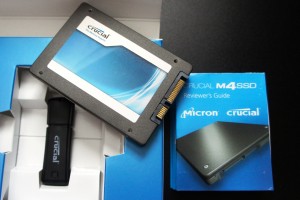For many models of solid state drives, the last two years has been turbulant with certain models dropping from $3/GB to less than $1/GB. A quick look at e-tailers, even today, shows quality brand name SSDs as low as the 80-90 cents/GB range. The Crucial M4 256GB SSD has even been seen on sale as low as 67 cents/GB! According to a recent ComputerWorld article, prices for SSDs dropped 20% in the second quarter of 2012, and another 10% in the second half of this year.
 Industry analysts IHS iSupply attribute much of this to an oversupply of NAND flash memory. Manufacturing is now more in line with demand, and prices have finally begun to stabilize. Price-monitoring specialists Dynamite Data have been tracking the price, rebate status, and stock status of more than 600 individual SSDs sold through hundreds of e-merchants since 2009.
Industry analysts IHS iSupply attribute much of this to an oversupply of NAND flash memory. Manufacturing is now more in line with demand, and prices have finally begun to stabilize. Price-monitoring specialists Dynamite Data have been tracking the price, rebate status, and stock status of more than 600 individual SSDs sold through hundreds of e-merchants since 2009.
Most recently (August 2012), Dynamite Data noted in a blog post that SSD prices had finally broken the $1/GB threshold, and proclaimed it to be “the new normal”
THE DYNAMITE DATA TAKE ON THINGS
According to Kristopher Kubicki, chief architect at Dynamite Data, “We first saw low-budget SSDs hit the $1 mark in April, with heavy mail-in rebates. However, the industry has been very consistent and extremely fast in its direction. The bigger and newer players pushed the bottom quartile (price) from $1.50/GB to $1/GB in just four months!” Kubicki goes on to state that “We’re currently experiencing the fastest decline in SSD prices in three years. If history has anything to say, we will now see prices per drive stabilize and the size of the drives substantially grow over the next few years.”
DRAMeXchange, a storage and memory tracking site, has also reported similar SSD pricing downward trends. As of this November, it noted that SSD prices were down 24% from the beginning of 2012. This is coupled with the fact that HDD prices have remained rather “inflated” — about 47% higher than prior to the 2011 floods in Thailand. Only recently are we seeing HDD prices finally starting to head downward a tad. DRAMeXchange’s Jessica Chang notes that “Despite hard drive prices remaining high — coupled with the continual decline of SSD prices — the per-GB price of the largest capacity SSDs (in the 300-600GB range) are currently nine times more expensive than 500GB notebook hard drives.” This compares to as much as nearly 30 times higher only a couple of years ago.
As far as companies that are making and shipping consumer-grade SSDs through channel suppliers, Intel and Samsung hold the #1 and #2 market positions, respectively. Rounding out the top five are OCZ, Micron (Crucial), and Kingston. When it comes to SSDs shipped to OEM system partners, the top players are Samsung, Toshiba, Intel, Micron, and Sandisk. OEM shipments will continue to remain the dominant SSD market.
 IHS SSD and storage analyst Ryan Chien points out that “Samsung hadn’t really been a big aftermarket SSD player until its 830 SSD came out; a combination of aggressive pricing and improved drive performance has catapulted it near the top fairly quickly.
IHS SSD and storage analyst Ryan Chien points out that “Samsung hadn’t really been a big aftermarket SSD player until its 830 SSD came out; a combination of aggressive pricing and improved drive performance has catapulted it near the top fairly quickly.
Intel drives are dependable, but not as fast; OCZ products have always struggled with reliability and the recent shakeups have not helped.” Samsung is continuing the upward growth with their new 840 series of SSDs.
Providing all of their own components and software gives them a huge advantage over many of their competitors.
The continued evolution of SSD technology to smaller die size NAND flash modules will allow larger capacities in the same form factors. Continued proliferation of SSDs in notebooks, ultrabooks, and laptops all help manufacturers achieve economies of scale in the form of reduced production costs per unit. More manufacturers and assemblers continue to push into the SSD market. All of these factors are contributing to greater supply, broader choices for the consumer, and most of all the benefit of the continued downward pricing trends!
 The SSD Review The Worlds Dedicated SSD Education and Review Resource |
The SSD Review The Worlds Dedicated SSD Education and Review Resource | 